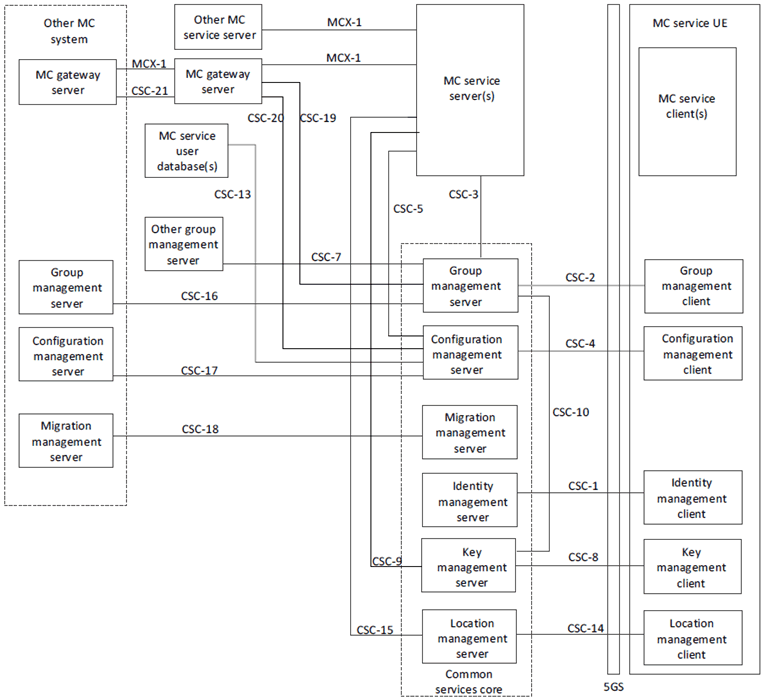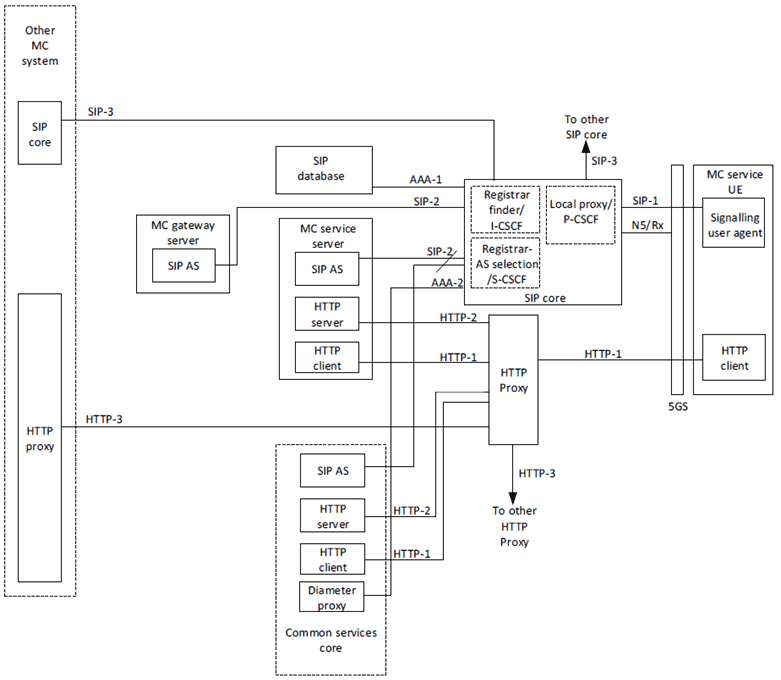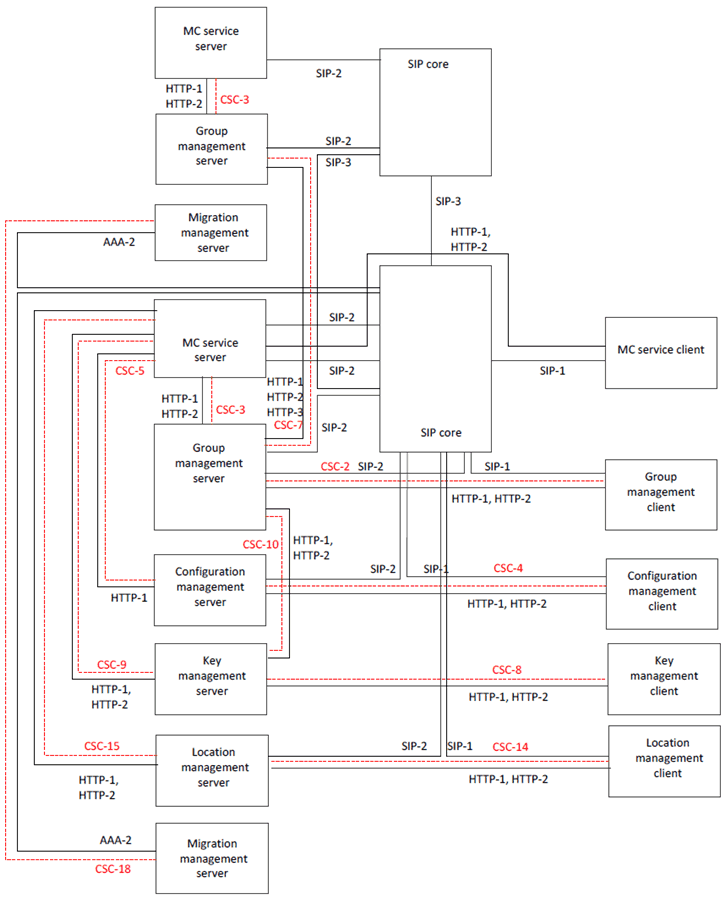Content for TS 23.289 Word version: 19.0.0
0…
4…
4.7…
4.7.4…
4.8…
5…
5.4…
6…
6.3…
6.3.2…
7…
7.2.4…
7.3…
7.3.3…
7.3.3.2…
7.3.3.4…
7.3.3.5…
7.3.3.7…
7.3.3.8…
7.3.3.9…
7.3.3.10…
7.3.3.11…
7.3.3.12…
7.3.3.13…
7.4…
7.5…
7.6…
A…
5 MC system functional model
5.1 General
5.2 Description of the planes
5.3 Common functional model description
5.3.1 On-network functional model
5.3.2 Functional entities description
5.3.2.1 General
5.3.2.2 Application plane
5.3.2.3 Signalling control plane
5.3.3 Reference points
5.3.3.1 General reference point principle
5.3.3.2 Application plane
5.3.3.3 Signalling control plane
5.3.4 Off-network functional model
...
...
5 MC system functional model p. 24
5.1 General p. 24
The functional model for the MC services architecture is defined as a series of planes to allow for the breakdown of the architectural description. Each plane is expected to operate in an independent manner, providing services to the connected planes as and when requested by the connected plane, and requesting services from other planes as required.
In this context, each plane manages on its own behalf:
- Use of identities: Each plane is responsible for the privacy of that plane's own identities; and
- Security for that plane: It does not preclude a plane requesting security services from another plane, but that is a decision made within the plane, as to whether to use offered security services or mechanisms within the plane itself.
5.2 Description of the planes p. 25
The following planes are identified:
- application plane: The application plane provides all of the services (e.g. call control, floor control, video control, data control, conferencing of media, provision of tones an announcements) required by the user together with the necessary functions to support MC service. It uses the services of the signalling control plane to support those requirements.
- signalling control plane: The signalling control plane provides the necessary signalling support to establish the association of users involved in an MC service, such as an MCPTT call or other type of MC services. The signalling control plane also offers access to and control of services across MC services. The signalling control plane uses the services of session connectivity.
5.3 Common functional model description p. 25
5.3.1 On-network functional model p. 25
Each MC service can be represented by an application plane functional model. The corresponding functional model across MC services may be similar but is described by the individual functional entities and reference points that belong to that MC service. Within the application plane for an MC service, a common set of functions as well as reference points is shared across MC services and is referred as the common services core.
Figure 5.3.1-1 shows the common functional model for the application plane for an MC system using 5GS.

Figure 5.3.1-1: Common functional model for application plane for an MC system
(⇒ copy of original 3GPP image)
(⇒ copy of original 3GPP image)
Figure 5.3.1-1 shows the common functional model for the application plane for an MC system using 5GS.
The common services core functions and reference points shown in Figure 5.3.1-1 are shared across each MC service.
Figure 5.3.1-2 shows the common functional model for the signalling control plane using 5GS.

Figure 5.3.1-2: Common functional model for signalling control plane
(⇒ copy of original 3GPP image)
(⇒ copy of original 3GPP image)
In the model shown in Figure 5.3.1-2, the SIP core may interact directly with 5GS via the N5 reference point or Rx reference point to control QoS on a per communication flow in accordance with TS 23.501.
Figure 5.3.1-3 shows the relationships between the reference points of the common application plane of an MC service server and the common signalling plane.

Figure 5.3.1-3: Relationships between reference points of the common MC service application plane and signalling control planes
(⇒ copy of original 3GPP image)
(⇒ copy of original 3GPP image)
5.3.2 Functional entities description p. 29
5.3.2.1 General p. 29
Each subclause is a description of a functional entity and does not imply a physical entity.
5.3.2.2 Application plane p. 29
The description of the application plane entities in TS 23.280 applies.
5.3.2.3 Signalling control plane p. 29
The description of the signalling control plane entities in TS 23.280 applies.
5.3.3 Reference points p. 29
5.3.3.1 General reference point principle p. 29
The protocols on any reference point that is exposed for MC service interoperability with other SIP core or other IMS entities in other systems shall be compatible with the protocols defined for the corresponding reference point defined in TS 23.002.
5.3.3.2 Application plane p. 29
5.3.3.2.1 General p. 29
The definition of the application plane reference points in TS 23.280 applies.
5.3.3.3 Signalling control plane p. 29
5.3.3.3.1 General p. 29
The reference points for the SIP and HTTP signalling are described in the following subclauses.
5.3.3.3.2 Reference point SIP-1(between the signalling user agent and the SIP core) p. 29
The SIP-1 reference point, which exists between the signalling user agent and the SIP core for establishing a session in support of MC service, shall use the Gm reference point as defined in TS 23.002 (with necessary enhancements to support MC service requirements and profiled to meet the minimum requirements for support of MC services). The SIP-1 reference point fulfils the requirements of the 5G-GC1 reference point, and is used for:
- SIP registration (including the UE's capabilities, for example eMBMS capable, or MBS capable UE);
- authentication and security to the service layer;
- event subscription and event notification;
- overload control;
- MBS session management; e.g., MBS session announcement and de-announcement; and
- media negotiation.
5.3.3.3.3 Reference point SIP-2 (between the SIP core and the SIP AS) p. 30
The SIP-2 reference point, which exists between the SIP core and the SIP AS for establishing a session in support of MC service, shall use the ISC and Ma reference points as defined in TS 23.002. The SIP-2 reference point is used for:
- notification to the MC service server(s) of SIP registration (including the UE's capabilities, for example eMBMS capable, or MBS capable UE) by the MC service UE;
- authentication and security to the service layer;
- event subscription and event notification;
- session management; and
- media negotiation.
5.3.3.3.4 Reference point SIP-3 (between the SIP core and SIP core) p. 30
The description of the SIP-3 reference point in TS 23.280 applies.
5.3.3.3.5 Reference point HTTP-1 (between the HTTP client and the HTTP proxy) p. 30
The description of the HTTP-1 reference point in TS 23.280 applies.
5.3.3.3.6 Reference point HTTP-2 (between the HTTP proxy and the HTTP server) p. 30
The description of the HTTP-2 reference point in TS 23.280 applies.
5.3.3.3.7 Reference point HTTP-3 (between the HTTP proxy and HTTP proxy) p. 30
The description of the HTTP-3 reference point in TS 23.280 applies.
5.3.3.3.8 Reference point AAA-1 (between the SIP database and the SIP core) p. 30
The description of the AA1-1 reference point in TS 23.280 applies.
5.3.3.3.9 Reference point AAA-2 (between the SIP core and Diameter proxy) p. 30
The description of the AA1-2 reference point in TS 23.280 applies.
5.3.3.3.10 Reference points N5 and Rx (between the SIP core and the 5GS) p. 30
5.3.4 Off-network functional model |R18| p. 30
The description of functional model for off-network operation in clause 7.3.2 of TS 23.280 applies.
The description of functional model for off-network operation of MCPTT service in clause 7.3.2 of TS 23.379 applies.
The description of functional model for off-network operation of MCVideo service in clause 6.1.2 of TS 23.281 applies.
The description of functional model for off-network operation of MCData service in clause 6.4.2 of TS 23.282 applies.